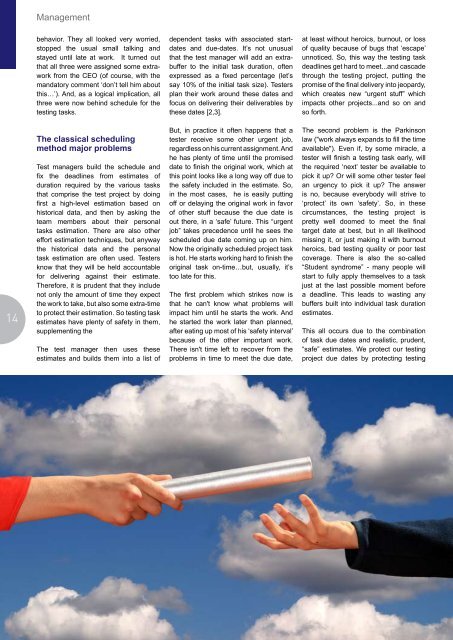Comparison of Change Management Systems
Comparison of Change Management Systems
Comparison of Change Management Systems
You also want an ePaper? Increase the reach of your titles
YUMPU automatically turns print PDFs into web optimized ePapers that Google loves.
14<br />
<strong>Management</strong><br />
behavior. They all looked very worried,<br />
stopped the usual small talking and<br />
stayed until late at work. It turned out<br />
that all three were assigned some extrawork<br />
from the CEO (<strong>of</strong> course, with the<br />
mandatory comment ‘don’t tell him about<br />
this…’). And, as a logical implication, all<br />
three were now behind schedule for the<br />
testing tasks.<br />
The classical scheduling<br />
method major problems<br />
Test managers build the schedule and<br />
fix the deadlines from estimates <strong>of</strong><br />
duration required by the various tasks<br />
that comprise the test project by doing<br />
first a high-level estimation based on<br />
historical data, and then by asking the<br />
team members about their personal<br />
tasks estimation. There are also other<br />
effort estimation techniques, but anyway<br />
the historical data and the personal<br />
task estimation are <strong>of</strong>ten used. Testers<br />
know that they will be held accountable<br />
for delivering against their estimate.<br />
Therefore, it is prudent that they include<br />
not only the amount <strong>of</strong> time they expect<br />
the work to take, but also some extra-time<br />
to protect their estimation. So testing task<br />
estimates have plenty <strong>of</strong> safety in them,<br />
supplementing the<br />
The test manager then uses these<br />
estimates and builds them into a list <strong>of</strong><br />
dependent tasks with associated startdates<br />
and due-dates. It’s not unusual<br />
that the test manager will add an extrabuffer<br />
to the initial task duration, <strong>of</strong>ten<br />
expressed as a fixed percentage (let’s<br />
say 10% <strong>of</strong> the initial task size). Testers<br />
plan their work around these dates and<br />
focus on delivering their deliverables by<br />
these dates [2,3].<br />
But, in practice it <strong>of</strong>ten happens that a<br />
tester receive some other urgent job,<br />
regardless on his current assignment. And<br />
he has plenty <strong>of</strong> time until the promised<br />
date to finish the original work, which at<br />
this point looks like a long way <strong>of</strong>f due to<br />
the safety included in the estimate. So,<br />
in the most cases, he is easily putting<br />
<strong>of</strong>f or delaying the original work in favor<br />
<strong>of</strong> other stuff because the due date is<br />
out there, in a ‘safe’ future. This “urgent<br />
job” takes precedence until he sees the<br />
scheduled due date coming up on him.<br />
Now the originally scheduled project task<br />
is hot. He starts working hard to finish the<br />
original task on-time…but, usually, it’s<br />
too late for this.<br />
The first problem which strikes now is<br />
that he can't know what problems will<br />
impact him until he starts the work. And<br />
he started the work later than planned,<br />
after eating up most <strong>of</strong> his ‘safety interval’<br />
because <strong>of</strong> the other important work.<br />
There isn't time left to recover from the<br />
problems in time to meet the due date,<br />
at least without heroics, burnout, or loss<br />
<strong>of</strong> quality because <strong>of</strong> bugs that ‘escape’<br />
unnoticed. So, this way the testing task<br />
deadlines get hard to meet...and cascade<br />
through the testing project, putting the<br />
promise <strong>of</strong> the final delivery into jeopardy,<br />
which creates new “urgent stuff” which<br />
impacts other projects...and so on and<br />
so forth.<br />
The second problem is the Parkinson<br />
law ("work always expands to fill the time<br />
available"). Even if, by some miracle, a<br />
tester will finish a testing task early, will<br />
the required ‘next’ tester be available to<br />
pick it up? Or will some other tester feel<br />
an urgency to pick it up? The answer<br />
is no, because everybody will strive to<br />
‘protect’ its own ‘safety’. So, in these<br />
circumstances, the testing project is<br />
pretty well doomed to meet the final<br />
target date at best, but in all likelihood<br />
missing it, or just making it with burnout<br />
heroics, bad testing quality or poor test<br />
coverage. There is also the so-called<br />
“Student syndrome” - many people will<br />
start to fully apply themselves to a task<br />
just at the last possible moment before<br />
a deadline. This leads to wasting any<br />
buffers built into individual task duration<br />
estimates.<br />
This all occurs due to the combination<br />
<strong>of</strong> task due dates and realistic, prudent,<br />
“safe” estimates. We protect our testing<br />
project due dates by protecting testing



